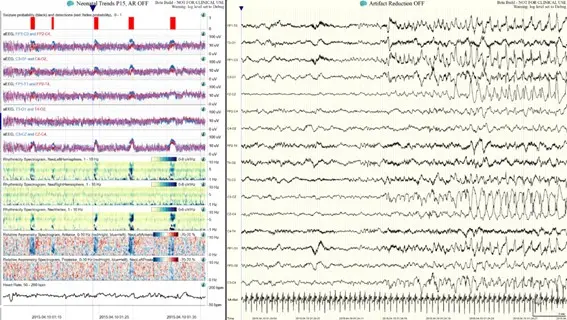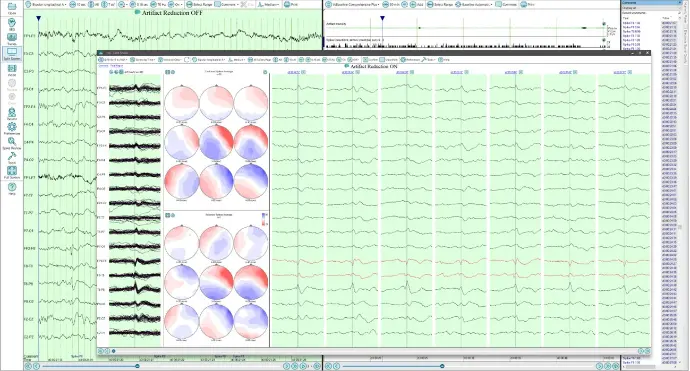New
Persyst
Seizure Detection
New Neonate Seizure Detection

Seizures
are the most common neurological emergency in the neonatal
period.1 Due
to the developmental anatomy of the neonate, many will have mostly or
exclusively electrographic-only seizures that only become apparent on
EEG, making EEG essential for the diagnosis and monitoring of
neonatal seizures.
✔︎ To enhance the utility of neonatal EEG monitoring further, Persyst 15 now includes a new Neonatal Seizure Detector, allowing clinicians to more efficiently assess and quantify seizure burden in neonates.
The Persyst 15 Neonatal Seizure Detector operates on reduced electrode arrays, from double-distance down to just three electrodes.
Using the validation data set for the neonatal seizure detector and the same methodological approach as used in our previous publications, the P15 Neonatal Seizure Detector was found to be non-inferior to a panel of three board-certified physician experts.*
Persyst
continues to push the edge of what AI and deep learning can do in
EEG; striving to offer useful tools for clinicians that increase both
efficiency and patient outcomes. Combined with an optimized trend
panel, Persyst 15 can assist in the monitoring and analysis of
neonatal recordings.

New Neonate Seizure Detection

Seizures
are the most common neurological emergency in the neonatal
period.1 Due
to the developmental anatomy of the neonate, many will have mostly or
exclusively electrographic-only seizures that only become apparent on
EEG, making EEG essential for the diagnosis and monitoring of
neonatal seizures.
✔︎ To enhance the utility of neonatal EEG monitoring further, Persyst 15 now includes a new Neonatal Seizure Detector, allowing clinicians to more efficiently assess and quantify seizure burden in neonates.
The
Persyst 15 Neonatal Seizure Detector operates on reduced electrode
arrays, from double-distance down to just three electrodes.
Using the validation data set for the neonatal seizure detector and the same methodological approach as used in our previous publications, the P15 Neonatal Seizure Detector was found to be non-inferior to a panel of three board-certified physician experts.*
Persyst
continues to push the edge of what AI and deep learning can do in
EEG; striving to offer useful tools for clinicians that increase both
efficiency and patient outcomes. Combined with an optimized trend
panel, Persyst 15 can assist in the monitoring and analysis of
neonatal recordings.

*There is a general need in the field to assess the rates of interreader agreement for neonatal seizures. Some studies show interreader agreement as being fair to moderate.2,3
Referências:
[1] Pressler RM, Cilio MR, Mizrahi EM, Moshe SL, Nunes ML, Plouin P, Vanhatalo S, Yozawitz E, de Vries LS, Vinayan KP, Triki CC, Wilmshurst JM, Yamatomo H, Zuberi SM. The ILAE Classification of Seizures & the Epilepsies: Modification for Seizures in the Neonate. Epilepsia (2021) 00:1-14.
[2] Shellhaas RA, Gallagher PR, Clancy RR. Assessment of Neonatal Electroencephalography (EEG) Background by Conventional and Two Amplitude-Integrated EEG Classification Systems. The Journal of Pediatrics (2008) 153(3):369-374.
[3] Wusthoff CJ, Sullivan J, Glass HC, Shellhaas RA, Abend NS, Chang T, Tsuchida TN. Interrater agreement in the interpretation of neonatal electroencephalography in hypoxic-ischemic encephalopathy. Epilepsia (2017) 58(3):429-435.
*There
is a general need in the field to assess the rates of interreader
agreement for neonatal seizures.
Some studies show interreader
agreement as being fair to moderate.2,3
Referências:
[1] Pressler RM, Cilio MR, Mizrahi EM, Moshe SL, Nunes ML, Plouin P, Vanhatalo S, Yozawitz E, de Vries LS, Vinayan KP, Triki CC, Wilmshurst JM, Yamatomo H, Zuberi SM. The ILAE Classification of Seizures & the Epilepsies: Modification for Seizures in the Neonate. Epilepsia (2021) 00:1-14.
[2] Shellhaas RA, Gallagher PR, Clancy RR. Assessment of Neonatal Electroencephalography (EEG) Background by Conventional and Two Amplitude-Integrated EEG Classification Systems. The Journal of Pediatrics (2008) 153(3):369-374.
[3] Wusthoff CJ, Sullivan J, Glass HC, Shellhaas RA, Abend NS, Chang T, Tsuchida TN. Interrater agreement in the interpretation of neonatal electroencephalography in hypoxic-ischemic encephalopathy. Epilepsia (2017) 58(3):429-435.